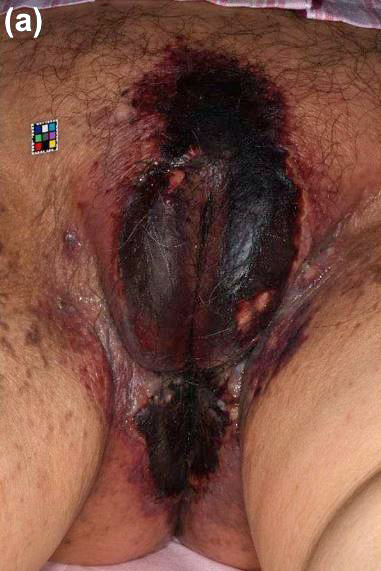
| WELCOME |
 |

comments, ephemera, speculation, etc. (protected political speech and personal opinion) 2021- 2021-12-07 b THE COVID-CON II Genital necrosis with
cutaneous thrombosis after COVID-19 mRNA vaccination
______________________Thrombosis is a [not so] rare complication of COVID-19 vaccines that typically affects cerebral and visceral vessels. However, skin involvement is largely unknown. Here, we describe a case of genital necrosis associated with cutaneous thrombosis following COVID-19 vaccination.  An 84-year-old
Japanese woman presented to our department with a
three-day history of genital necrosis. She had
received her first dose of Pfizer–BioNTech BNT162b2
mRNA COVID-19 vaccine 26 days before admission. Nine
days after the vaccination, she developed increasing
pain in her genital region. She denied any trauma or
precipitating event. Her medical history was
significant for deep vein thrombosis after orthopedic
surgery, for which she had been receiving edoxaban
over the past three years. She had no other risk
factors for thrombosis. An 84-year-old
Japanese woman presented to our department with a
three-day history of genital necrosis. She had
received her first dose of Pfizer–BioNTech BNT162b2
mRNA COVID-19 vaccine 26 days before admission. Nine
days after the vaccination, she developed increasing
pain in her genital region. She denied any trauma or
precipitating event. Her medical history was
significant for deep vein thrombosis after orthopedic
surgery, for which she had been receiving edoxaban
over the past three years. She had no other risk
factors for thrombosis.On admission, she was well but febrile to 37.5°C. Dermatological examination revealed extensive necrosis with surrounding purpura that involved the mons pubis, labia majora, and perineum (Fig. 1a). Laboratory investigations showed a leukocytosis (15.9 × 109/L) with a left shift. The platelet count was slightly elevated (359 × 109/L). The coagulation profile was unremarkable. Biochemical parameters were within the normal range except for an elevated C-reactive protein (11.6 mg/dL, normal <0.3 mg/dL). A thrombophilia screen—including antithrombin, protein C, protein S, lupus anticoagulant, anti-cardiolipin antibodies, anti-β-2-glycoprotein-1 antibodies—was unremarkable. Serological tests for rheumatoid factor, anti-nuclear antibody, and anti-neutrophil cytoplasmic antibodies were all negative. Pelvic CT was performed to show subcutaneous fat stranding without fascial thickening. No hemorrhage or hematoma was noted. CT angiography detected no evidence of thrombosis. Skin biopsy showed epidermal necrosis, scattered neutrophils and lymphocytes in the dermis, and thrombotic occlusion of dermal vessels with mild perivascular infiltration (Fig. 1b,c). Immunohistochemistry revealed that the thrombi were positive for CD61, a platelet-specific marker (Fig. 1d,e). Based on the clinical and histopathological findings, a diagnosis of cutaneous necrosis with platelet thrombi formation and secondary infection was made. Treatment was started with ampicillin/sulbactam along with local wound care. Her fever, leukocytosis, and genital pain resolved within the first week. The skin lesions also improved: more than 80% of the eschar had fallen off when she was discharged after one month of admission (Fig. 2a), and epithelization was almost completed another month later (Fig. 2b). A small but increasing number of thrombotic events have been reported since the launch of mass vaccination campaigns against COVID-19. Adenovirus vector-based vaccines (AstraZeneca and Johnson & Johnson) are associated wit severe thrombosis with thrombocytopenia, while mRNA-based vaccines (Pfizer–BioNTech and Moderna) are also associated with some thrombotic events, which do not always accompany thrombocytopenia. The exact pathogenesis remains unknown, but platelet activation is thought to be a key feature underlying these events. For both types of vaccines, thrombosis typically occurs in unusual locations such as cerebral and portal veins. However, only two cases of skin involvement have been reported, both of which manifested as local skin necrosis at injection sites. To the best of our knowledge, this is the first case of extensive skin necrosis after COVID-19 vaccination that developed outside the injection site. Although the mechanism of platelet thrombi formation in genital skin is unclear, the short time interval between the vaccination and the onset of symptoms may indicate a causal relationship. Therefore, our case extends the range of cutaneous manifestations associated with thrombosis after COVID-19 vaccination. In addition, it should be noted that she developed thrombosis despite receiving edoxaban, which highlights the need to consider the possibility of thrombosis even in patients under anticoagulant therapy. Although rare skin necrosis should be recognized as a possible manifestation of thrombosis associated with COVID-19 vaccination. (read more) Permission is hereby granted to any and all to copy and paste any entry on this page and convey it electronically along with its URL, ______________________ |
...
News and facts for
those sick and tired of the National Propaganda Radio
version of reality.
|
|||||
|

| If
you let them redefine words, they will control
language. If you let them control language, they will control thoughts. If you let them control thoughts, they will control you. They will own you. |
| © 2020 - 2021 - thenotimes.com - All Rights Reserved |